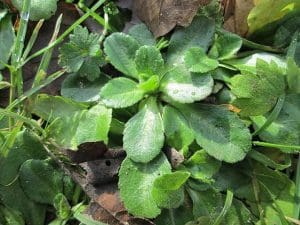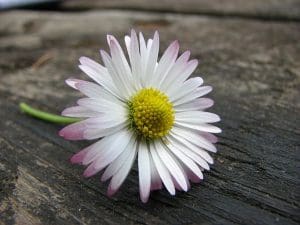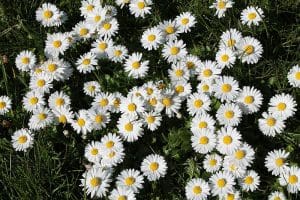Daisy / All Year Round / Edible
An abundant, perennial, wild edible that all of us are familiar with, if only from making ‘daisy bracelets’ as a child. They can be found almost anywhere on any soil type.
Common Names
Daisy, Common Daisy, Lawn Daisy, English daisy, Bruisewort, Gardeners’ Friend
Botanical Name
Bellis perennis
Scientific Classification
Kingdom – Plantae
Order – Asterales
Family – Lamiaceae
Physical Characteristics for Daisy
Leaves
The leaves are small, dark green and they are rounded to spoon shaped. 2-5 cm long they grow from a central rosette.

Flowers
The flower head grows on a hairy stem from the centre of the rosette, it’s not a true flower as such but a composite of a number of tiny flowers which make up the yellow disc in the middle (‘disc florets’) and the surrounding white ‘ray florets’ (which look just like petals).

Habitat
Virtually anywhere, most common on lawns, meadows and woodland clearings.
Known Hazards
None Known
Could be Confused with…
There are many plants that could look similar so I’d recommend only collecting the leaves when the flowers are present.
Edible Uses
The young leaves are nice added to salads and have a unique medicinal flavour but they do get very bitter with age.
The flowers have a milder flavour and can be used in salad or as a garnish.
Notes on Herbal Uses
The Daisy has a long and rich history in herbal medicine and is one of the most therapeutic herbs in the UK.
The plant is high in saponins and it is thought that these chemicals help skin cells produce collagen. It can be used for treating skin diseases and external wounds.
The common name Gardeners’ Friend refers to its use in treating aches and pains.
Infusions or tinctures made from the plant are taken internally as a medicine to treat coughs, bronchitis, disorders of the liver and kidneys, and inflammation.
Modern research also shows that the leaves contain more Vitamin C than lemons.
Extra notes from the Foragers
The botanical name Bellis may come from bellus, the Latin for ‘pretty’ and perennis is Latin for ‘everlasting’
The common name Daisy is thought to come from ‘Days End’ as the flowers close at night and open again in the morning.
Resources:
https://www.plantlife.org.uk/uk/discover-wild-plants-nature/plant-fungi-species/daisy
https://en.wikipedia.org/wiki/Bellis_perennis
https://www.wildlifetrusts.org/wildlife-explorer/wildflowers/common-daisy








Leave a Reply
You must be logged in to post a comment.